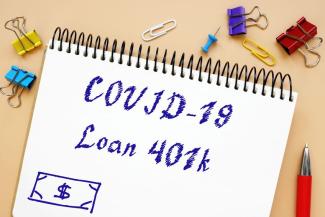
Is Now the Time to Give Yourself a 401(k) Loan?
In planning how to finance a large purchase before age 59 ½, it’s common to consider the idea of taking a withdrawal or a loan from a 401(k) or another retirement account. Taking money from your retirement funds is not a decision to be made lightly. But if you’re experiencing hardship because of the coronavirus pandemic, you may want to think about borrowing or withdrawing money from your 401(k) to help. The Coronavirus Aid, Relief and Economic Security (CARES) Act includes provisions to make it easier and more sensible for some to access their retirement funds.
What Has Changed Under the CARES Act?
Normally, you can withdraw or borrow up to 50% or $50,000 from your 401(k) savings before age 59 ½. A premature withdrawal usually comes with a 10% penalty and at least 20% automatic withholding from taxes.
Under the CARES Act, you can now borrow or withdraw up to $100,000 from employer-sponsored and personal retirement accounts, or a combination of the two. The 10% penalty is waived for distributions made in 2020 and there are no mandatory withholding requirements. However, if you don’t pay back the amount you withdrew, the distribution will be taxed as income evenly over the years 2020, 2021 and 2022. If you do pay back the amount within three years, you can claim a refund on those taxes.
You can also take out up to 100% or $100,000 as a loan and defer payments for up to one year.
Who is Eligible?
Not everyone is eligible to take advantage of these 401(k) benefits. If you, your spouse or a dependent has been diagnosed with COVID-19, you are automatically eligible. Otherwise, if you have suffered from financial hardship due to the pandemic, you may be eligible. This could include a number of circumstances that you, your spouse or a member of your household has experienced, including:
-
Being furloughed, laid off or under mandatory quarantine.
-
Having work hours cut, income reduced, or a job offer rescinded or delayed.
-
Being unable to work because of the lack of childcare.
-
Being a business owner who has had to reduce hours or close a business.
Even if you’re still employed, you may be eligible for a distribution from your 401(k) if you have had one or more of these hardships.
Consider Your Options Carefully
Consider the impact that a withdrawal from your account may have on compound interest over time. If you’re withdrawing with no plan for paying it back, you may be hurting your finances more in the long run than borrowing from somewhere else. But, especially if you’re experiencing a hardship like loss of income, withdrawing money from your 401(k) may make more sense than accumulating high-interest debt.
Be mindful of taxes in your specific situation. You can either claim your distribution as income all at once or spread it out over the next three years. In most cases, it’s better to spread the income out, as you’ll be less likely to bump yourself into a higher tax bracket. Although if you expect your income to be lower in 2020 than the two subsequent years, claiming the distribution all at once may result in a better tax situation.
It’s also important to know the difference between taking a withdrawal and a loan from your 401(k). If you make a withdrawal, repayment isn’t required, there’s no penalty and you have a few different tax options.
With a loan, repayment is required within a specific time period, usually five years. The loan amount isn’t taxed or given a penalty fee initially, but if you fail to pay it back within five years you will be charged a 10% penalty. In addition, if you leave your employer with an outstanding 401(k) loan balance, you will owe the remainder by mid-October of the next year. If you don’t pay the balance before this date you’ll be charged an early withdrawal penalty.
If you’re struggling to figure out whether taking a withdrawal or loan from your 401(k) is right for your needs, consult a financial professional to figure out what your best plan of action may be.
This material has been prepared by a third party that is unaffiliated with Townsend Asset Management Corp. and is provided for informational purposes only. It may not represent the views of Townsend or its affiliates. Townsend has obtained permission to distribute this material. The information provided is not written or intended as tax or legal advice and may not be relied on for purposes of avoiding any Federal tax penalties. Individuals are encouraged to seek advice from their own tax or legal counsel. Neither the information presented nor any opinion expressed constitutes a representation by us of a specific investment or the purchase or sale of any securities. Asset allocation and diversification do not ensure a profit or protect against loss in declining markets. Townsend Asset Management Corp. is an independent investment adviser registered under the Investment Advisers Act of 1940, as amended. Registration does not imply a certain level of skill or training. More information about the firm can be found in its Form ADV Part 2, which is available upon request. TAM-20-52.

